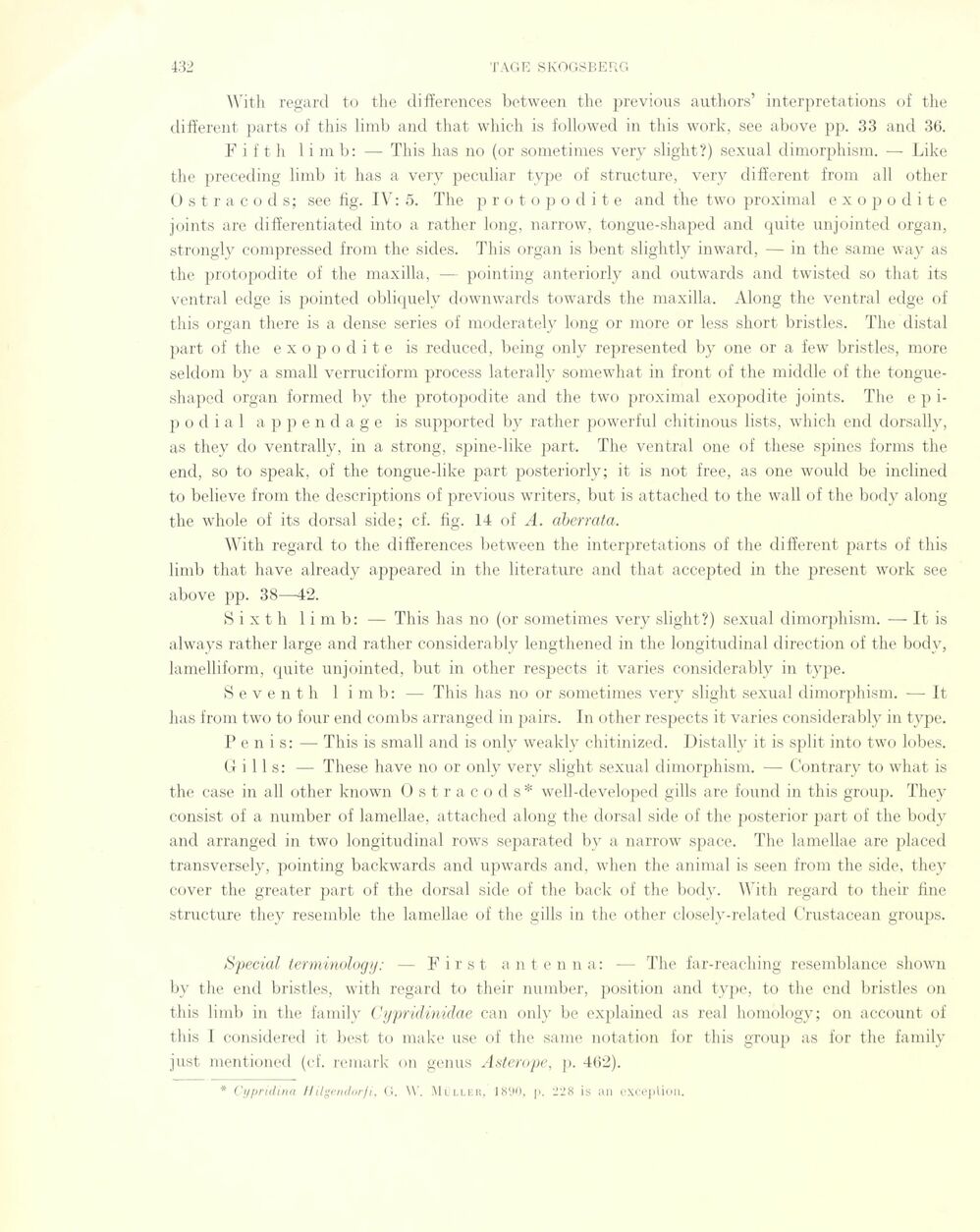
Full resolution (JPEG) - On this page / på denna sida - Sidor ...

<< prev. page << föreg. sida << >> nästa sida >> next page >>
Below is the raw OCR text
from the above scanned image.
Do you see an error? Proofread the page now!
Här nedan syns maskintolkade texten från faksimilbilden ovan.
Ser du något fel? Korrekturläs sidan nu!
This page has never been proofread. / Denna sida har aldrig korrekturlästs.
With regard to the differences between the previous authors’ interpretations of the
different parts of this limb and that which is followed in this work, see above pp. 33 and 36.
F i f t h 1 i in b: —- This has no (or sometimes very slight?) sexual dimorphism. — Like
the preceding limb it has a very peculiar type of structure, very different from all other
Ostracods; see fig. IV: 5. The protopodite and the two proximal exopodite
joints are differentiated into a rather long, narrow, tongue-shaped and quite unjointed organ,
strongly compressed from the sides. This organ is bent slightly in ward, — in the same way as
the protopodite of the maxilla, — pointing anteriorly and outwards and twisted so that its
ventral edge is pointed obliquely downwards towards the maxilla. Along the ventral edge of
this organ there is a dense series of moderately long or more or less short bristles. The distal
part of the exopodite is reduced, being only represented by one or a few bristles, more
seldom by a small verruciform process laterally somewhat in front of the middle of the
tongue-shaped organ formed by the protopodite and the two proximal exopodite joints. The e p
i-p o d i a 1 appendage is supported by rather powerful chitinous lists, which end dorsally,
as they do ventrally, in a strong, spine-like part. The ventral one of these spines forms the
end, so to speak, of the tongue-like part posteriorly; it is not free, as one would be inclined
to believe from the descriptions of previous writers, but is attached to the wall of the body along
the whole of its dorsal side; cf. fig. 14 of A. aberrata.
With regard to the differences between the interpretations of the different parts of this
limb that have already appeared in the literature and that accepted in the present work see
above pp. 38—42.
S i X t h limb: — This has no (or sometimes very slight?) sexual dimorphism. — It is
always rather large and rather considerably lengthenecl in the longitudinal direction of the body,
lamelliform, quite unjointed, but in other respects it varies considerably in type.
Seventh limb: — This has no or sometimes very slight sexual dimorphism. —■ It
has from two to four end combs arranged in pairs. In other respects it varies considerably in type.
Penis: — This is small and is only weakly chitinized. Distally it is split into two lobes.
Gills: — These have no or only very slight sexual dimorphism. •—- Contrary to what is
the case in all other known Ostracods* well-developed gills are found in this group. They
consist of a number of lamellae, attached along the dorsal side of the posterior part of the body
and arranged in two longitudinal rows separated by a narrow space. The lamellae are placed
transversely, pointing backwards and upwards and, when the animal is seen from the side, they
cover the greater part of the dorsal side of the back of the body. With regard to their fine
structure they resemble the lamellae of the gills in the other closely-related Crustacean groups.
Special terminolog y: — First a n t enna: —- The far-reaching resemblance shown
by the end bristles, with regard to their number, position and type, to the end bristles on
this limb in the family Cypridinidae can only be explained as real homology; on account of
this I considered it best to make use of the same notation for this group as for the family
just mentioned (cf. remark on genus Asterope, p. 462).
* Cypridina Hilgendorji, G. \V. Müller, 1890, p. 228 is an exception.
<< prev. page << föreg. sida << >> nästa sida >> next page >>